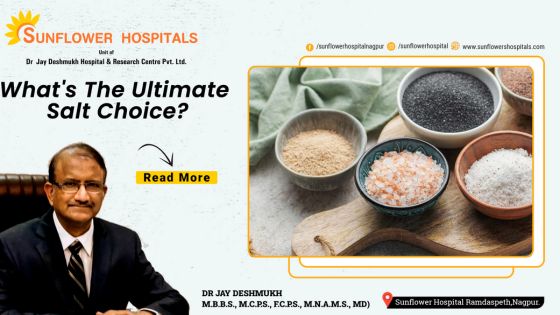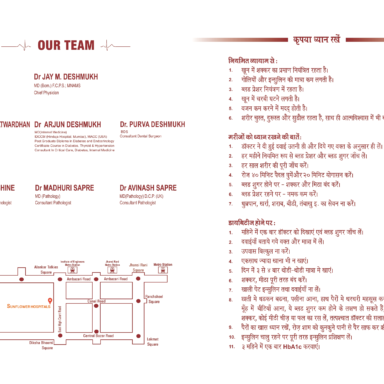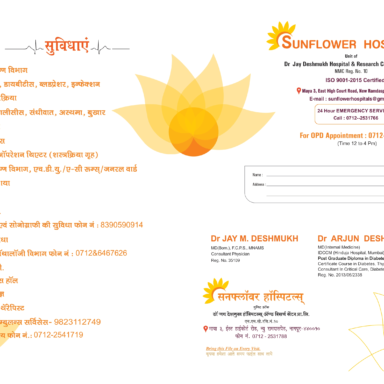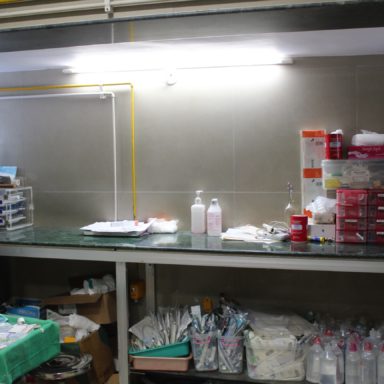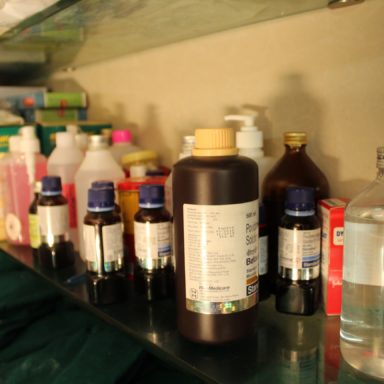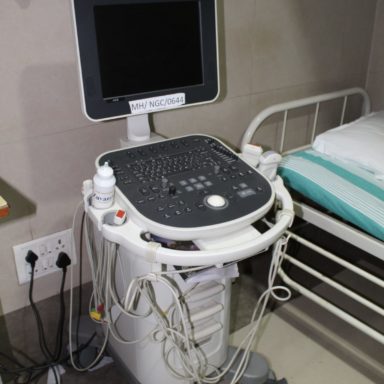Sunflower Multispecialty Hospital Nagpur
Sunflower Hospital Nagpur is a Hi-Tech medical complex with 37 beds, It was incepted in the year 1990They are one of the well-known Hospitals in Ramdas Peth. Backed with a vision to offer the best in patient care and equipped with technologically advanced healthcare facilities, they are one of the upcoming names in the healthcare industry the out-patient department with excellent support services incorporating all branches of Medicine, Surgery, Gynecology, and super specialties. We have Our departments 24 Hours Open – Patient Casualty, Accident and Emergency Services. Dr Jay Deshmukh Nagpur
This hospital is also located at Ramdas Peth. A team of well-trained medical staff, non-medical staff and experienced clinical technicians work round-the-clock to offer various services.
Hospital is Well-equipped most modern Intensive Coronary Care Unit (ICCU),
Intensive Pulmonary Care Unit (IPCU), with fully qualified & experienced Doctors dr Jay Deshmukh, Nurses and Paramedical Personnel.

Emergency services
24/7 Emergency Ambulance Service Available.
Qualified Doctors
We have a Great team Of Qualified Experience Doctor.
24/7 support
Hospitality Service is Available 27/7.
Online appointment
For Your Convenient We have started Online Appointment Service.
Dr. Jay Deshmukh
Dr Jay Deshmukh Ramdaspeth
General Physician With The Great experience Of 40 Years.
M.B.B.S., M.C.P.S., F.C.P.S., M.N.A.M.S., MD
(Internal Medicine – Bombay and New Delhi)
Chief Physician and Director, Sunflower Hospital, Nagpur
Ex. Honorary Physician to Honorable Governor of Maharashtra and Pondicherry
Central Mine Planning & Design Institute Ltd. And Western Coal Fields
Director, Orange City Hospital and Research Institute, Nagpur
Ex. Honorary Associate Professor (Medicine) Jawaharlal Nehru Medical College, Sawangi (M), Wardha.
Chairman, Central India Ethics committee.
Chairman, Trust for Family Physicians

Balkrishna Sudamji Prize
Mister we could use a man like Herbert Hoover again. Love exciting and new. Come aboardwere expecting you.
Know MoreSmt. Babubahi Vahil Prize
In crack commando was sent to prison by a military court for a crime they didn't commit. These men prompt-
Read MoreDr.B.R.Damle Gold Medal
Come aboard expecting you. Love life's sweetest reward Let it flow it floats back to you. It's a beautiful Day.
Read MoreExcellence In healthcare Award 2020
Dr. Jay Deshmukh has achieved Lokmat times Excellence In Healthcare for outstanding contribution 2020 awards for his great contribution to the medical field.
Read MoreDr. Arjun Deshmukh
Dr Arjun Deshmukh Ramdaspeth
Working as a Critical Care, Diabetes specialist in Sunflower Hospital, Nagpur.
35 bedded hospital from Last 3 years
M.B.B.S. – NKP Salve Institute of Medical Sciences, Nagpur
MD(IDCCM), JNMC, Wardha. Passed in December 2012
PGCDM Indore, PGCAT Indore, CCEBDM, NAGPUR
Certificate courses in DIABETES
Certificates course in THYROID disorders
Certificate courses in HYPERTENSION
Certificate course in
cardiovascular disorders
PG courses in CARDIOLOGY & GASTROENTEROLOGY
Advanced course in ECHOCARDIOGRAPHY
Worked in Echo Centre in Arneja Heart Institute, Nagpur 2015
As an observer in Midas Institute, Nagpur, In the Endoscopy Unit in 2015

What are the causes of irritable bowel syndrome? Despite intensive research, the causes are not clea [...]
Why causes depression? Depression is caused by chemical imbalances in the brain called neurotransmit [...]
What should be the ideal salt intake? Unfortunately ,most people consume 2-3 times more than the rec [...]
Doctors

Dr.Arjun Deshmukh

Dr.Jay Deshmukh




